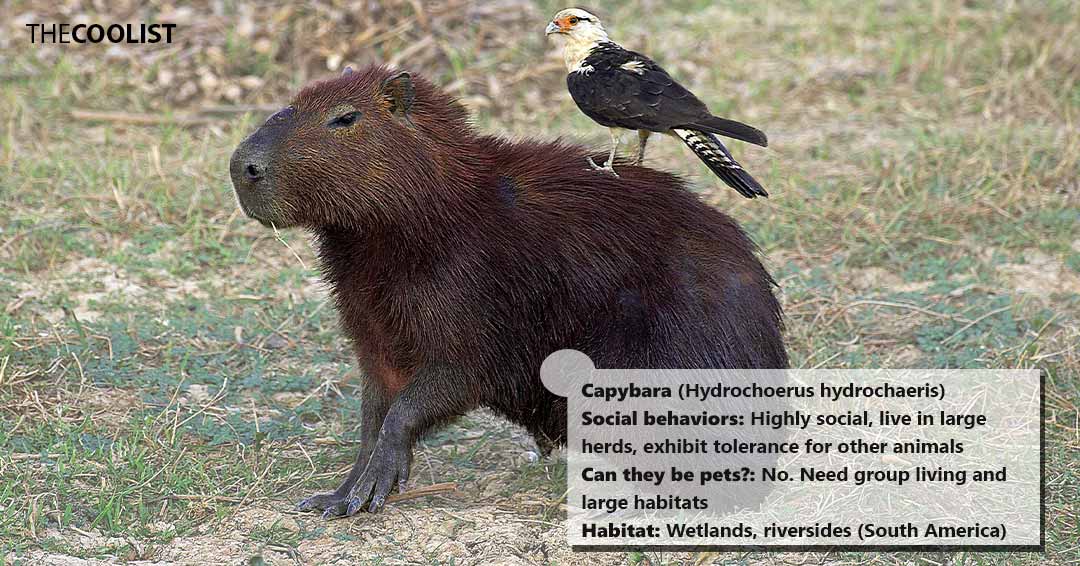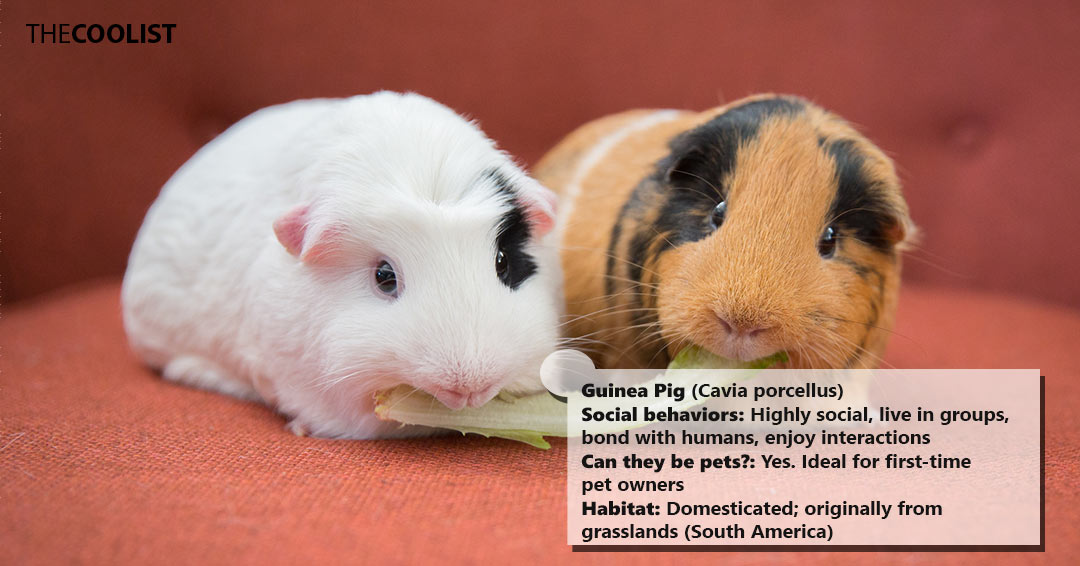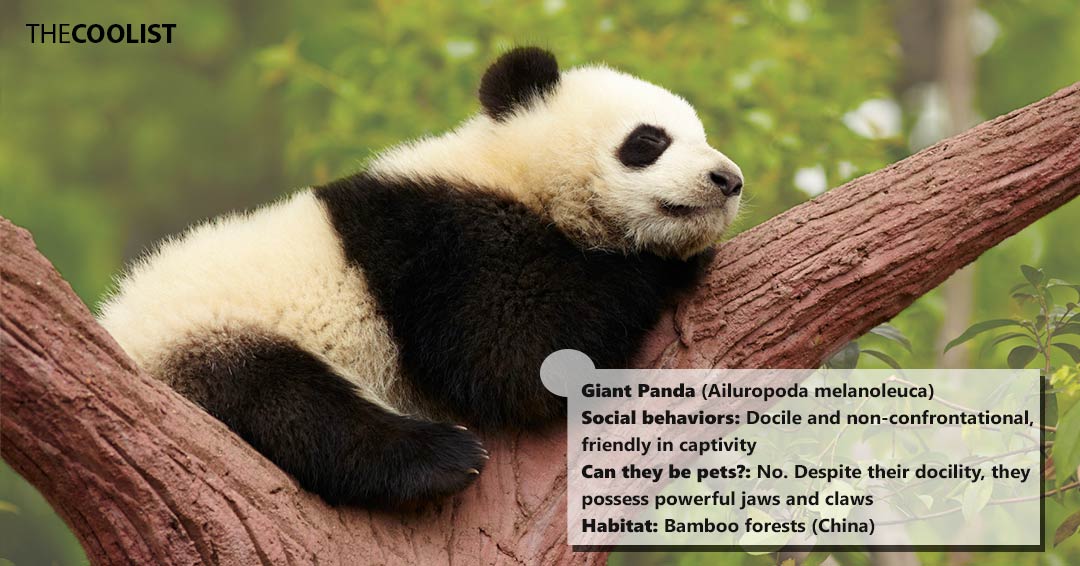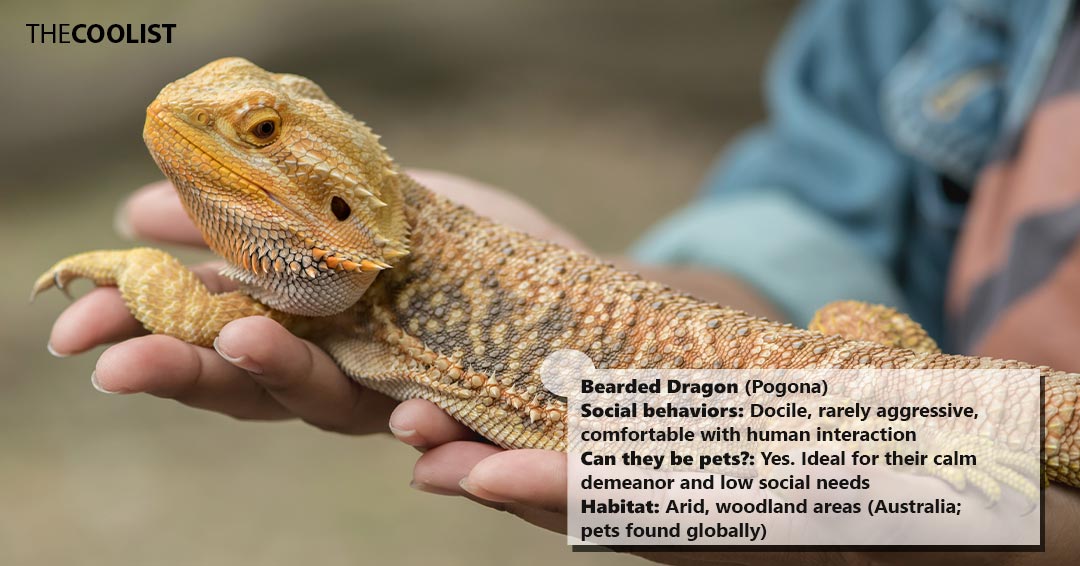The friendliest animals in the world are uniquely docile, passive, or tolerant. Many species demonstrate social instincts, but our list of friendliest animals highlights those humans often find endearing. Some are pets and livestock, while others are wild animals with noteworthy characteristics.

Friendliness in animals is the result of many factors. For instance, domestication led to genetic and behavioral changes that enhanced sociability and reduced aggression. Certain species, like cats, dogs, or horses, are consequently more amenable to human interaction. Meanwhile, wild animals like capybaras developed to be more passive or tolerant due to their surroundings. Others, such as dolphins, exhibit intellectual curiosity and playfulness.
These creatures are popular with humans as they have a profound impact on us or their environment. Many fulfill roles, most notably being affectionate companions. That said, there is no definitive nicest animal in the world as many can be aggressive if under threat or distress. Consequently, it’s important to treat them with respect. If they’re pets or live in captivity, they must be cared for, or if they’re wild, they shouldn’t be approached.
We’ll explore the following 11 friendliest animals.
- Capybara: Capybaras are large, gentle, and sociable rodents. They often coexist peacefully with other animals.
- Cat: Domestic cats are affectionate and loving. They express themselves in many ways, even mirroring their owners as a form of attachment.
- Dog: Dogs are the most loyal animals, dubbed man’s best friend. Their domestication promotes distinct, social behaviors that create strong bonds.
- Rabbit: Domestication led rabbits to be docile and friendly. They like to interact and play with both their human owners and fellow rabbits.
- Horse: Horses are herd animals typically bred to be docile and amenable. They’re important to human history due to their ability to cooperate and communicate.
- Dolphin: Dolphins are highly intelligent and sociable, particularly among their own. Dolphins maintain close-knit pods and have positive interactions with humans.
- Guinea pig: Guinea pigs are affectionate and gentle pets, thriving on social interaction with humans and other guinea pigs.
- Sheep: Sheep land on this list as another domestic animal. Their flocking mentality contributes to their socability while their docile nature makes them great pets.
- Giant panda: Giant pandas exhibit passive behavior due to their diets. In captivity, pandas are playful, affectionate, and curious towards humans.
- Bearded dragons: Bearded dragons are calm and tolerant reptiles, showing friendliness through their tolerance to physical contact and bond with owners.
- Llamas: Llamas are sociable domestic animals. They rely on their herd for companionship while humans often trust them to be pack animals, guards, or even pets.
1. Capybara
Capybaras (Hydrochoerus hydrochaeris) are large, docile rodents native to South America. Their reputation as one of the friendliest animals in the world stems from both their pack behavior and tolerance. Capybaras live in herds of dozens to hundreds of individuals. They form bonds, groom each other, share food, and sleep in huddles. They’re highly communicative as well, expressing a range of vocalizations or scent signals. Aggression between capybaras is rare as they rely on social harmony for survival.
View in gallery
A lack of aggression additionally allows them to tolerate other animals. For instance, they often coexist with birds, monkeys, and even some predators in the wild. Capybaras will flee if attacked but lack a strong territorial instinct. They instead present non-aggression, adapting to the presence of other animals as a means of survival. Consequently, capybaras get along with humans as well.
Some capybaras allow humans to feed or pet them, and enjoy the presence of domestic creatures like dogs. However, capybaras themselves cannot be kept as pets. They need to live in groups and require a sizable space to roam, including water sources to swim in. Moreover, legal restrictions bar domestic capybaras due to the complexity of their care and pet trade concerns. Their passivity, size, and appearance make them popular among humans, however, with herds in urban areas often drawing in crowds.
2. Cat
Cats (Felis catus) are longtime companions of humans with diverse personalities and social behaviors. Domestic cats are the result of centuries of cooperation and selective breeding. Consequently, every cat is unique due to their genetics and rearing. Well-socialized and well-trained cats are highly affectionate—expressing themselves through meows, purrs, thrills, and distinctive body language to highlight positive interactions. They also initiate physical contact. Cats will rub against legs, lie on laps, or sleep next to humans if there’s established trust and affection.
View in gallery
Cats even mirror their owners as a form of attachment. They respond to your routine, moods, and general disposition. For instance, if you’re an active, outing person, it’s likely your cat demonstrates similar behaviors. Beyond humans, cats are friendly towards other cats and other animals. However, felines are territorial. This may lead to confrontations or stress in multi-animal households. Establishing a territory and hierarchy is vital for them, necessitating careful introduction to ensure friendly behaviors.
Domestic cats largely exist to be companions, though you’ll find stray or feral cats in urban areas. The latter can’t be kept as pets if they’re an adult because they have adapted to a life without human dependency. Strays may be taken in, though how friendly they are varies on past interactions with humans, personalities, and age.
3. Dog
Dogs (Canis lupus familiaris) are colloquially called man’s best friend due to centuries of domestication. They demonstrate highly social pack behaviors that endear them to humans and other animals. For example, dogs express friendliness by wagging their tails, licking faces, and engaging in play. These behaviors additionally highlight how dogs are eager to form bonds and seek approval, be it from humans or canines. It is instinctual, though social skills require proper reinforcement to ensure positive interactions.
View in gallery
A well-trained dog is obedient and responds to situations appropriately. They’re eager to play or receive attention but also respect their owners’ directions. Additionally, different breeds demonstrate different social behaviors that color their disposition. For instance, lap dogs are bred for companionship and tend to be very affectionate, whereas herding dogs show their friendliness by working closely with humans.
Dogs make great pets due to these behaviors. However, just as lap and herding canines differ, so does every dog’s personality. Those who show aggression are precarious choices for pets and require expert handling to develop friendliness. Canine sociability extends to other animals, such as cats or rabbits, with dogs expressing affection if the individuals are compatible.
4. Rabbit
Domestic rabbits (Oryctolagus cuniculus) develop close bonds with humans and display a friendly disposition. They enjoy pets, treats, and learning tricks and cues. They’ll approach their human owners and express contentment through soft purring sounds, nudging their noses, or hopping around playfully. Such behaviors are important for rabbits as socializing supports their mental and physical health.
View in gallery
Wild rabbits live in colonies and depend on each other for protection. Domestic rabbits likewise benefit from having other rabbits around, though social attitudes differ somewhat among breeds. For example, larger breeds like Flemish Giants are calm and docile. On the other hand, smaller breeds like Lionhead rabbits might be more energetic and needy for attention.
That said, any well-reared rabbit is friendly. They’re ideal pets due to their behavior and require less social training than dogs. Meanwhile, their wild cousins cannot be kept as pets despite being very social animals. They have different needs and lack the centuries of reinforcement that made domestic rabbits docile and affectionate.
5. Horse
Horses (Equus ferus caballus) are large and intelligent hoofed animals humans domesticated centuries ago. A combination of strong herd instincts and human handling defines their social behavior, allowing for collaboration and close bonds. Modern horses function as transportation, labor, entertainment, medical aides, and companions. Some are bred to be vivacious and competitive, but many well-trained horses display a docile disposition, landing them on this list.
View in gallery
For example, horses can express affection. They nuzzle humans, respond to pets and brushing, react to vocal cues, and abide by commands given proper training. Herd mentality additionally means they form bonds with other horses. In herds, horses follow a social hierarchy and maintain connections by grooming each other, initiating physical contact, and communicating through body language or vocalization. Horses are sometimes sociable towards other animals, expressing tolerance, curiosity, or affection.
The exact barrier between livestock and pet horses varies. Most horses are kept as the former and fulfill various roles as one of the friendliest and amenable animals in the world. However, many are seen as pets. They provide companionship and develop emotional connections with their owners, heightened by their intelligence and herd mentality.
6. Dolphin
Dolphins (Cetacea) are highly playful and social aquatic mammals. Different species of dolphins have distinct behaviors, but friendliness characterizes the animal as a whole due to their many positive interactions. For example, dolphins live in close-knit groups called pods which thrive on social play. They swim together, touch fins, chase each other, and play with objects like seaweed to create bonds. Dolphins even display empathy, guiding injured members to the surface to breathe or protecting them from predators.
View in gallery
Meanwhile, dolphins demonstrate intellectual curiosity and a cordial attitude toward humans. They often approach boats and swimmers. Some initiate contact and respond to humans’ gestures, though this is most evident in captive dolphins. Wild dolphins may act aggressively if they’re under threat or stress.
As a result, dolphins can’t be pets. Those in captivity fulfill various roles, including research, therapy, and entertainment. In these settings, dolphins are especially affectionate towards humans and form emotional bonds. Controversy surrounds dolphins in captivity, as they need vast environments to thrive, but are nevertheless loved as one of the friendliest animals in the world.
7. Guinea pig
Guinea pigs (Cavia porcellus) are rodents commonly kept as pets. They rank as one of the friendliest animals because a strong social instinct governs most individuals. For instance, wild varieties live in small groups called herds, where they raise young and eat together. Domestic guinea pigs likewise benefit from companionship. Owners often attempt to pair individuals up. Doing so successfully establishes a noticeable bond. Together, guinea pigs will play, exercise, eat a more varied diet, and enjoy more mental stimulation—all of which are key to their overall well-being.
View in gallery
Some domestic guinea pigs may prefer to be solitary or do not successfully bond with other members. However, these animals still form affectionate bonds with their owners. They’re receptive to pets and cuddles, enjoy being picked up and held, and participate in play and training. Aggression is unlikely, making them suitable for first-time owners or children (given proper oversight).
Guinea pigs’ friendliness is mostly notable in pets. Their wild cousins are far more skittish and avoid humans. Additionally, pet guineas are sometimes cordial with other animals in the home. They may be curious and respond affectionately, especially with calm pets. However, these interactions require careful supervision to avoid stress or injury.
8. Sheep
Domestic sheep (Ovis aries) are one of the most important types of livestock due to their social and amicable nature. Humans domesticated sheep as early as 11,000 BCE and they became central to many agricultural practices. Sheep exhibit a strong herd and follow instinct, which aided their domestication and characterized their mannerisms. Modern sheep stay close together, form large flocks, and follow the lead animal (called the bellwether as it often wears a bell collar). They also develop bonds with flock mates and display preferences for specific members, illustrating a social structure.
View in gallery
Sheep’s friendliness extends to humans due to domestication. Sheep trust and are largely comfortable with humans they know. Lambs (baby sheep) are especially playful. They will run, jump, and seek affection from their mother, flockmates, and humans, particularly if they’re hand-reared. Many sheep are kept pets and enjoy human interaction, seeking out companionship and responding to their names.
Those that aren’t pets are less affectionate but generally docile or skittish. They won’t readily approach unless you offer food or are familiar to them. That said, rams (male sheep who haven’t been castrated) are notably aggressive and may attack if you approach. Consequently, it’s important to keep your distance from a flock you don’t know.
9. Giant panda
Giant pandas (Ailuropoda melanoleuca) are the most docile relatives of the Ursidae bear family. Their passivity is likely the result of their primarily herbivorous diet, which provides little energy. They’ve additionally adapted to be non-confrontational, though they lack high social instincts (which is common among bears). Even so, giant pandas demonstrate behaviors that endear them to humans, landing them on our list.
View in gallery
For example, pandas in captivity are particularly friendly. They engage with caregivers, investigate their activities, and take food directly from humans. They respond to enrichment activities and display playful behaviors like rolling, climbing, and demanding attention, particularly if they’re young.
Pandas cannot be pets, however. Human presence is consistent and accepted by captive pandas, but caretakers approach them carefully as these animals have powerful jaws and claws. Though this isn’t typical, they can become aggressive if under threat or stress. Meanwhile, wild pandas should never be approached. They’re cautious and avoid human contact, prioritizing solitude and their diets.
10. Bearded dragons
Bearded dragons (Pogona) are a favorite among reptile enthusiasts due to their docile nature. Wild bearded dragons tend to flee from humans but are rarely aggressive compared to other reptiles. Pet bearded dragons are especially passive. They’re comfortable with being held, fed, and petted. They display curiosity and often approach their owners unprompted.
View in gallery
Notably, bearded dragons aren’t social animals. Few reptiles are, so the docility and friendliness of this species are unique. They don’t require companions as pairings may cause stress or aggression. Additionally, they don’t need bonding in the same way other animals do, such as dogs or cats. Even so, bearded dragons are one of the friendliest reptiles because they enjoy being around humans and respond to attention.
As a result, bearded dragons are popular exotic pets. They provide companionship without high social needs or space. Their calm demeanor and tolerance for handling also make them ideal for educational purposes and first-time owners, fostering an appreciation for reptiles.
11. Llamas
Llamas (Lama glama) are domesticated camelids native and pivotal to South America. They exhibit a friendly demeanor thanks to their domestication 6,000 to 7,000 years ago. Modern llamas have a close bond with humans as well as members of their species. They live in herds and bond by softly humming, nuzzling, and playing. They exhibit cooperative and protective behaviors, alerting each other (or humans) to threats or dangers.
View in gallery
Llamas’ friendliness extends to humans, whom they are often gentle and affectionate toward. Well-reared llamas respond to pets and demonstrate a calm, docile attitude. Llamas are also known for spitting. However, this is a means of enforcing dominance between herd members. Spitting on humans is rare—so much so that llamas are a common fixture at petting zoos, allowing children and adults alike to pet their wooly coats.
The amenable nature of llamas makes them great pets and livestock. They thrive best with companions to satisfy their social needs. Llamas even protect other animals (namely sheep) if integrated as a guard, and serve as pack animals for South American herders. Those kept as pets should live on a farm or in rural areas, where they have space to roam and graze and receive attention from both their herd and owners.
How do friendly animals affect the ecosystem?
The world’s friendliest animals affect ecosystems by promoting balance or disbalance through their various interactions. An ecosystem refers to complex networks of relationships between living elements (such as animals) and their surroundings. Ecosystems are part of the broader natural environment, which animals affect and vice versa. For example, largely domestic animals like cats, dogs, or horses are not immediately in the wild but still affect their surroundings.
Outdoor cats and dogs often prey on wildlife, which harms local populations. Conversely, many cats and dogs aid pest control, which is vital for agriculture, community health, and ecological balance. Horses graze, which may lead to overgrazing and soil erosion. However, they also help disperse plant seeds through their manure.
Wild but friendly animals such as capybaras and dolphins have different effects. For instance, capybaras are prey animals and are an essential component of their local food webs, with predators keeping their populations in check. In turn, capybaras graze on aquatic plants, which prevents overgrowth and maintains open waterways. Likewise, dolphins maintain marine ecosystems by controlling fish populations. They’re likewise prey for larger sharks and orcas, which prevent severe depletion of food sources.
What friendly animal is most loyal to humans?
The friendliest animals most loyal to humans are dogs. Whether a canine—or any friendly pet species—is the right fit for you depends on your lifestyle, but dogs are generally loyal to humans thanks to instinctive loyalty. Appropriate training and reinforcement further their dedication. For example, they protect families, herd livestock, detect threats, and serve as crucial medical aides. The human-canine connection is paramount to many aspects of life, making man’s best friend one of the friendliest and most loyal animals.
Which wild animals are friendly to humans?
Many wild animals are friendly to humans, namely dolphins, capybaras, and giant pandas. These animals demonstrate high levels of passivity or curiosity, making them tolerant and sometimes welcoming of human presence. That said, captive animals or those who dwell in urban areas encounter humans more often, which aids tolerance and creates bonds. Meanwhile, wild varieties should not be approached. This can cause stress and trigger a flight or fight response, leading to injury or the transfer of bacteria or diseases. Additionally, many countries bar contact if the animal is endangered. It’s important to treat all animals with respect, as they may respond aggressively if you invade their personal space.
How do you take care of the friendly and nicest animals?
Taking care of any friendly animal depends on the species. Not every friendly creature is a pet which complicates care. Moreover, personalities and health differ, so exact needs vary even for domestic species.
General requirements come down to providing food, water, shelter, veterinary care, as well as mental, social, and physical enrichment. Food and water are essential, as is ensuring the animal’s dietary needs are met according to its species, age, and health. Some animals have especially sensitive stomachs. Others sustain diverse diets. Meanwhile, appropriately sized shelters protect them and eliminate stressors. Regular veterinary care is also crucial for monitoring health and preventing diseases.
Furthermore, exercise and enrichment activities are necessary for physical health and mental stimulation. This is especially key for non-domestic, captive animals. Enrichment often mimics their natural behaviors and habitats, staving off burden and distress. Lastly, social interaction is vital. Most friendly animals we’ve discussed are social species, so they require appropriate companionship for their well-being.
Do friendly animals become aggressive?
Yes, friendly animals can become aggressive if they are under threat, pain, or distress. Likewise, animals that are typically friendly may be aggressive due to poor training, mishandling, or abuse. Environmental factors, such as a lack of space, likewise trigger aggression. For instance, a dog might growl or bite when its personal space is invaded or if it feels its food is being threatened. Similarly, a gentle horse may become irritable and kick if it’s kept in a confined space for too long or is exposed to constant stressors, such as loud noises.
What are the heaviest animals in the world?
The list below covers three examples of the heaviest animals in the world.
- Blue whale: Blue whales are the heaviest animals to ever live, weighing up to 200 tons (180,000 kg). These giants are also notable for their social behavior. They demonstrate a gentle disposition, though lead a mostly solitary lifestyle. However, mothers and calves have strong bonds, living together for a year or more.
- Elephant: Elephants are the heaviest land animals with the African elephant being the largest. They weigh up to 10.4 tons (9,500 kg). Additionally, elephants are notably friendly and intelligent, though occasionally dangerous. They form close families, showing affection through touching and protection.
- Polar bear: Polar bears are the heaviest bears, achieving up to 2,200 lbs (1,000 kg). Polar bears are not social animals and instead exist as apex predators of the Arctic landscape. That said, mothers care for their young, rearing and protecting them for over two years.
What are the tallest animals in the world?
Below are three examples of the world’s tallest animals.
- Giraffe: Giraffes are the tallest land animals, achieving up to 18 feet (5.5 m). They’re native to various areas of Africa where they live in everchanging groups and communities, though some are solitary.
- Elephant: African elephants again rank because males often reach a height of 13 ft (4 m). These imposing males are mostly solitary, though some may live in small groups with other males. They do not form bonds as strong as the matriarchal herds, though remain social and inquisitive creatures.
- Ostrich: Ostrich is another species native to Africa. It is the tallest bird in the world, reaching 9 ft (2.7 m). Wild ostriches live in groups with defined social structures. For instance, females share communal nests whereas a single adult male is dominant.
